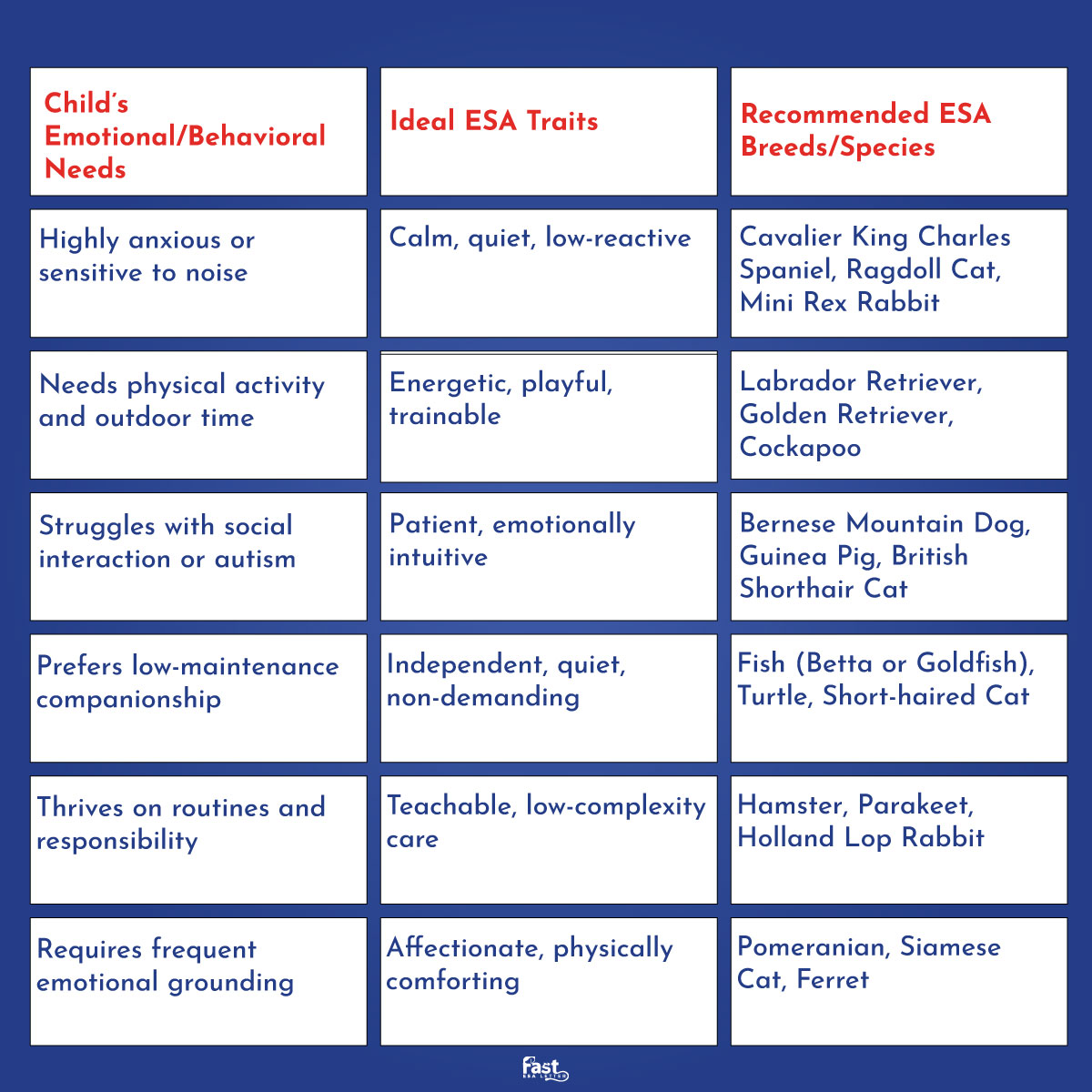How to Get an ESA Letter for Your Child in 2025? (Parent’s Guide)

Robert Clendenin, MD
As a parent, you always want the best for your little ones, especially when it comes to their emotional and mental well-being. If your child struggles with anxiety, depression, or other mental health challenges, you might have heard about the benefits of Emotional Support Animals (ESAs). But are you confused about whether an ESA is the best option for your little one or how you can get an ESA letter for your child? Worry not. Let’s walk through the process together, keeping in mind that selecting an ESA requires careful consideration to ensure it effectively meets your child’s emotional needs and integrates smoothly into your family dynamic.

Key Points
- How Do I Get An ESA Letter For My Child In 2025? Book a consultation with a licensed therapist, complete the assessment, and receive an ESA letter.
- Is The Process Different For Minors? No, parental consent is required, but clinicians follow the same federal standards used for adults.
- Does The Letter Expire? Yes. Renew annually to keep housing rights active.
- Can Schools Refuse An ESA? Schools decide on a case‑by‑case basis. Provide documentation early and request reasonable accommodation.
- What Animals Qualify? Any domesticated species that offers emotional benefits, typically dogs, cats, rabbits, or guinea pigs.
How Emotional Support Animals Help Children?
Emotional support animals (ESAs) help children feel calmer, connected, and emotionally secure. Their presence can ease anxiety, support emotional regulation, and gently encourage social interaction in shy or withdrawn kids. Many children also find it easier to stick to daily routines when supported by a familiar, comforting companion.
Does My Child Need an Emotional Support Animal?
1. Persistent Anxiety or Depression
2. Social Withdrawal or Selective Mutism
3. Struggles with Daily Tasks
4. Sensory Sensitivities (e.g., Autism Spectrum)

What Skills Can Children Develop With an Emotional Support Animal?

How to Get an ESA Letter for Your Child in 2025?
If you’re considering an emotional support animal for your kid, securing a valid ESA letter is the first step toward accessing legal protections—especially for housing. Here’s how to get an ESA letter for a child in three simple steps:
1. Schedule a Consultation with a Licensed Mental Health Professional (LMHP)
Many parents streamline this process by using Fast ESA Letter, a trusted platform that connects you with state-licensed professionals who understand the emotional needs of children. This is especially helpful if local providers have long wait times or limited pediatric experience.
2. Discuss Your Child’s Condition and the Need for an ESA
3. Receive a Legally Compliant ESA Letter
If your child qualifies, the licensed mental health professional will issue a legally recognized ESA letter for your kid, which must include:
- The LMHP’s full name, license type and number, and practice location
- A statement confirming your child has a DSM-5-recognized emotional or mental health condition
- A recommendation that an emotional support animal helps manage specific symptoms
- The date of issuance (letters are typically valid for 12 months and may need renewal)
Store this document securely—you’ll need it when applying for housing accommodations.

What’s the Best ESA for Your Child?
Choosing the right Emotional Support Animal (ESA) for your child requires more than picking a pet; they need a companion that matches their emotional profile, energy levels, and environment. The wrong choice could cause stress instead of support.
Use this comparison chart to find the ideal ESA based on your child’s traits:

How to Introduce an Emotional Support Animal to Your Child?
Step 1: Prepare a Calm Environment
Step 2: Allow Natural First Contact
Step 3: Reinforce Gentle Interaction
Step 4: Monitor the Bond and Adjust If Needed

Final Thoughts
Before moving forward, consult with a licensed mental health professional to determine if an ESA is appropriate. If recommended, you can obtain a valid ESA letter for children, which unlocks important housing protections and supports your child’s emotional well-being.
Frequently Asked Questions (FAQs)
How Do I Know If My Child Is Ready For An Emotional Support Animal (ESA)?
What Should I Consider About My Home Environment Before Getting An ESA?
Are Emotional Support Animals Allowed In Schools Or Classrooms?
How Can I Request ESA Access For My Child At School?
Submit a formal request letter along with:
- Your child’s ESA letter for school or public access
- Details of the child’s condition and support needs
- Behavioral history and the animal’s temperament
Tip: Include specific ways the ESA improves your child’s emotional stability or classroom functioning. The more detailed and therapeutic the justification, the better your chances of approval.
What If My Child Doesn’t Bond With The Emotional Support Animal?
Can My Child Have More Than One Emotional Support Animal?
Yes, in some cases, a child may qualify for more than one ESA, especially if each animal provides different types of emotional support. However, a licensed mental health provider must determine if multiple ESAs are clinically justified based on your child’s emotional or psychological needs.
Does An ESA Letter Give My Child Housing Rights?
Yes. Under the Fair Housing Act (FHA), a valid ESA letter for your child grants specific housing protections.
Landlords must:
- Allow your child’s emotional support animal in all housing, even with “no pets” policies
- Waive breed, weight, or pet-related fees
- Only deny access if the animal poses a direct safety risk or causes property damage
How Old Does My Child Need To Be To Get An ESA Letter?
Can A Pediatrician Write An ESA Letter For My Child?
Can My Child Have A Cat As An Emotional Support Animal?
Yes. Cats can be emotional support animals for children, especially if they offer comfort and help ease anxiety, depression, or other emotional conditions.
Do I Need To Renew My Child’s ESA Letter Every Year?
How Do I Explain An Emotional Support Animal To My Child?
How Long Does It Take To Get An ESA Letter For My Child?
Can My Child’s Emotional Support Animal Fly On Airlines?
Most U.S. airlines no longer recognize ESAs under federal law. However, some airlines may still allow ESAs as pets, subject to their pet travel policy. Always confirm in advance.
Does My Child’s ESA Need Special Training?
Can An Emotional Support Animal Help My Child With Autism?
What If My Landlord Refuses To Accept My Child’s ESA Letter?
Post Author
Prince Sharma
Related Articles
How Emotional Support Animals Help Veterans Reclaim Peace After Service?
How Emotional Support Animals Help Veterans Reclaim Peace After Service?Emotional Support Animals (ESAs) offer comfort and stability to veterans coping with PTSD, anxiety, and depression. They support veterans in rebuilding emotional resilience,...
Think Your ESA Is Illegal? These Laws May Surprise You.
Think Your ESA Is Illegal? These Laws May Surprise You.Breed restrictions do not typically apply to Emotional Support Animals (ESAs) under the Fair Housing Act (FHA). Landlords must accommodate ESAs regardless of breed, as long as they have proper...
Can a Guinea Pig Be an Emotional Support Animal?
Can a Guinea Pig Be An Emotional Support Animal?Yes, Guinea pigs can be a wonderful choice for emotional support animals. They offer comfort and companionship through their friendly behaviour. To have a guinea pig as an ESA, you’ll need an ESA letter...
Live Free with Your ESA!
An ESA Letter Unlocks Freedom!




